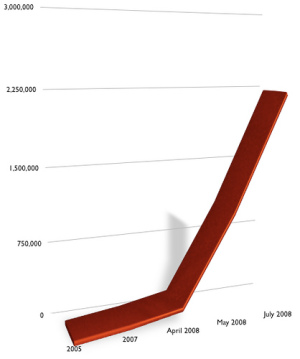Causes of Inflation
- published
- 2009-01-12

Zimbabwe Inflation Rate What could cause this hyperinflation? Photo courtesy of Gregor Rohrig
With the recent government bailouts, there is reason to be concerned about inflation in the near term. Inflation is not usually a big concern because most of the time it is small enough to ignore. Even when inflation does get high, interest rates often rise to above the level of inflation. This doesn't always happen however. You would have lost about half of the value of your money to inflation if you had left your money in an interest-bearing account during the period from 1941-1948. [Link]
There are many strategies to avoid losing money to inflation such as buying commodities, foreign currency, or treasury I-bills. Gold is one of the conventional hedges against inflation, but various factors can affect the value of gold, such as gold mining operations and government stockpiling and sales. The Swiss Franc is known as a fairly stable currency with low rates of inflation. Moving your money into an interest-bearing account in Swiss Francs could be a good option if you can get a good exchange rate. I Savings Bonds from the U.S. treasury pay an interest rate that is slightly above the CPI-computed rate of inflation. Government securities are promoted as the world's safest investments, but with the expanding national debt, some people are concerned about the solvency of the U.S. government. Though unprecedented, it is possible that unconstrained government spending could lead to a state where the government can't repay all of its debts. In this case, those treasury bonds could become worthless, but that would only happen in extremely bad situations, worse than the great depression.
In order to determine which strategies are best, it helps to understand what causes inflation. There is still dispute among economists about the true cause of inflation, but there are certain things that we know for sure. Inflation is defined as a rise in the general level of prices of goods and services over time. But this can be rephrased to make it easier to understand inflation. First of all, we can combine all goods and services into a composite index. An approximation of this is the Consumer Price Index (CPI), which represents the prices of a wide variety of consumer goods and services. And secondly, we can treat the dollar as a commodity that can be bought and sold just like any other good, perhaps using gold or some other standard of value. Then inflation is a measure of the change in the value ratio of the composite index to the dollar.
Inflation refers to increases in the value of goods and services with respect to money. According to classical economics, the value of a resource is determined by supply and demand. So there are four component factors that can cause market-based inflation: goods demand up, goods supply down, money demand down, money supply up. In addition there can be inflation that is not due to market factors.
-
Goods demand up (Demand-pull) The demand for goods can go up when a country goes to war and needs a lot of resources for battle. Example: America in World War II
-
Goods supply down (Cost-push) The supply of goods can go down when there are sudden trade restrictions or embargoes. Example: 1970s Oil Crisis in America
-
Money demand down The demand for money can go down when there is a lack of confidence in the economy or currency. Example: Europe's Black death
-
Money supply up The supply of money can go up due to large scale counterfeiting or governments printing money or lowering interest rates so that banks can create more money through lending. Example: Continental currency during the American Civil War
-
Non-market inflation Prices don't always stabilize to the market rates. Some factors can force prices higher than market rates, which constitutes inflation. Ex: Labor unions demanding wages above the market price. Note that this is not a case of cost-push inflation because the supply of goods does not necessarily go down, producers can simply pass the costs on to consumers.
These factors cover all the possible causes of inflation, but there is still the question of which are sustainable in the long term? A continual increase in the demand for goods is definitely sustainable in the long term, but tends to be offset eventually as the supply of goods rises to meet demand. Demand for money can't go down forever and non-market factors will eventually be curtailed by the power of market forces. Therefore increases in the money supply are the primary cause of sustained inflation. This is why Milton Friedman once said "Inflation is always and everywhere a monetary phenomenon."
This begs the question of what the money supply really is? Does it include semi-liquid assets such as the value of treasury bonds? Or in other words, should it be M1, M2, or M3? What about money that is under somebody's mattress for years? I'm not sure, but I think the answer is not going to be a clear cut yes or no for these questions. Money stored under a mattress for years is not playing any direct role in the economy, but it could influence the demand for money by the person who owns it. And semi-liquid assets probably play some role that depends on their liquidity.